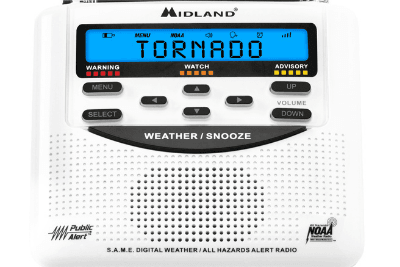NOAA Frequencies — Use Your Radio to Hear Weather Broadcasts

Table of Contents
Modern two-way radios have advanced weather alert systems that can help you remain alert regarding storms and dangerous weather conditions. These systems are linked to the National Oceanic and Atmospheric Administration (NOAA).
Getting caught in a storm at a high altitude, in the middle of the woods, or out at sea can be very dangerous. Therefore, if you are hiking with a group of people or your family, you want to have a radio with the latest weather technology. Receiving timely alerts enables you to seek shelter and stay safe as a storm approaches, for instance.
In addition to having a quality radio with a weather alert system, it’s essential to learn about NOAA weather alert radio frequencies. Familiarizing yourself with the technology and understanding how weather alert features work helps prepare you for a potential emergency.
What is NOAA?
The National Oceanic and Atmospheric Administration is a United States science agency that operates in the US Department of Commerce. The agency works on projects concerning the oceans, main waterways, and the atmosphere. NOAA states that its mission is to understand the Earth better and protect its resources. It works with partners around the globe to preserve the environment.
Some of the services provided by NOAA are weather forecasts, severe weather warnings, and climate monitoring.
How to Tune in to NOAA Broadcasts
NOAA provides a nationwide weather radio service. It broadcasts using a network of radio stations around the US, distributing the latest weather information sourced from the National Weather Service (NWS) departments in various regions. These radio broadcasts send out forecasts, weather observations, alerts, warnings, and potentially hazardous information, around the clock.
NOAA broadcasts can be accessed on regular radios, including those found in automobiles. However, these radios may not always be in range of the NOAA frequencies. For more reliable access, it’s recommended that you use a dedicated NOAA radio weather receiver.
Some receivers come with a range of valuable features. For example, the most crucial feature is that it sends automatic warning alerts if dangerous weather conditions are incoming in your area.
The public can receive NOAA weather alert radio frequencies from dedicated broadcasts on seven different frequencies in the VHF Public Service band:
162.400 MHz
162.425 MHz
162.450 MHz
162.475 MHz
162.500 MHz
162.525 MHz
162.550 MHz
Weather Alert Radios From Midland Radio
Midland Radio is a leading supplier of quality radio products, including those that pick up emergency weather broadcasts and alerts. If you’re in the market for a radio to take with you on your fishing and hunting expeditions and hikes, consider one of the following products:
WR400 Deluxe NOAA Weather Radio
This radio uses digital S.A.M.E (Specific Area Message Encoding) technology to access your area’s warning system. This provides you with immediate weather updates from the NWS. Midland Radio’s most advanced emergency alert radio allows you to program 25 counties with 80 separate emergency alerts. You can also plug in and charge electronic devices through its USB output.
WR120 NOAA Weather Alert Radio
The WR120 sets the standard when it comes to weather radios. For instance, it is designed with S.A.M.E technology, giving you over 60 different types of weather hazard alerts. The WR120 sends you instant alerts if the NWS issues a weather or hazard warning.
Always Prioritize Safety
Camping, hiking, sailing, and other adventures in nature enable us to connect with green and blue spaces and create special memories. Purchase a weather alert radio from Midland Radio and ensure you’re aware of adverse weather and potential safety hazards when you’re exploring the wilderness.




